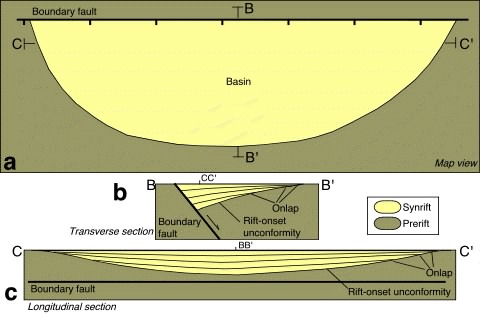
| Previous |
3.3. Tectonics of Rifting and Drifting: Pangea Breakup
3.3.1. Rift Basin Architecture and Evolution
Roy W. Schlische & Martha Oliver Withjack
Department of Geological Sciences, Rutgers University, Piscataway,
NJ 08854-8066 U.S.A.
Rift basins have been increasingly the focus of research in tectonics, structural geology, and basin analysis. The reasons for this interest include: (1) Rift basins are found on all passive (Atlantic-type) continental margins and provide a record of the early stages of (super)continental breakup. (2) The architecture of these basins and the basin fill are strongly influenced by the displacement geometry on the bounding normal fault systems (e.g., Gibson et al., 1989). Thus, aspects of the evolution of these fault systems, including their nucleation, propagation and linkage, can be extracted from the sedimentary record. (3) Many modern and ancient extensional basins contain lacustrine deposits (e.g., Katz, 1990) that are sensitive recorders of climate. Milankovitch cycles (e.g., Olsen and Kent, 1999) recorded in these strata provide a quantitative test of the predictions of basin-filling models (e.g., Schlische and Olsen, 1990) that can, in turn, be used to infer aspects of crustal rheology during rifting (e.g., Contreras et al., 1997). (4) Many of the major petroleum provinces of the world are associated with rift basins (e.g., the North Sea basins, the Jeanne d'Arc basin, the Brazilian rift basins).
This section provides a brief overview of the rift basins related to Pangean breakup, especially those along the central Atlantic margin (e.g., Olsen, 1997). In particular, we examine (1) the structural architecture of rift basins; (2) the interplay of tectonics, sediment supply, and climate in controlling the large-scale stratigraphy of rift basins; (3) how the sedimentary fill can be subdivided into tectonostratigraphic packages that record continental rifting, initiation of seafloor spreading, basin inversion, and drifting; and (4) how coring can be used to answer fundamental questions related to these topics.
Structural Architecture
A typical rift basin is a fault-bounded feature known
as a half graben (Fig. 3.3.1.1a). In a cross section oriented perpendicular
to the boundary fault (transverse section), the half graben has a triangular
geometry (Fig. 3.3.1.1b). The three sides of the triangle are the border
fault, the rift-onset unconformity between prerift and synrift rocks, and
the postrift unconformity between synrift and postrift rocks (or, for modern
rifts, the present-day depositional surface). Within the triangular wedge
of synrift units, stratal boundaries rotate from being subparallel to the
rift-onset unconformity to being subparallel to the postrift unconformity.
This fanning geometry, along with thickening of synrift units toward the
boundary fault, are produced by syndepositional faulting. Core from the
Newark basin confirms the thickening relationships (see Section 3.3.2).
Synrift strata commonly onlap prerift rocks. In a cross section oriented
parallel to the boundary fault (longitudinal section), the basin has a
synclinal geometry (Fig. 3.3.1.1c), although more complicated geometries
are associated with segmented boundary fault systems (e.g., Schlische,
1993; Schlische and Anders, 1996; Morley, 1999).
 |
| Figure 3.3.1.1. Geometry of a simple half graben. (a) Map-view geometry. (b) Geometry along a cross section oriented perpendicular to the boundary fault, showing wedge-shaped basin in which synrift strata exhibit a fanning geometry, thicken toward the boundary fault, and onlap prerift rocks. (c) Geometry along a cross section oriented parallel to the boundary fault, showing syncline-shaped basin in which synrift strata thin away from the center of the basin and onlap prerift rocks. |
The half-graben geometry described above is directly controlled
by the deformation (displacement) field surrounding the boundary fault
system (Gibson et al., 1989; Schlische, 1991, 1995; Schlische and Anders,
1996; Contreras et al. 1997). In a gross sense, displacement is greatest
at the center of the fault and decreases to zero at the fault tips (Fig.
3.3.1.2a); this produces the syncline-shaped basin in longitudinal section.
In traverse section, the displacement of an initially horizontal surface
that intersects the fault is greatest at the fault itself and decreases
with distance away from the fault. This produces footwall uplift and hanging-wall
subsidence, the latter of which creates the sedimentary basin (Fig. 3.3.1.2b).
However, this geometry is affected by fault propagation and forced folding
(e.g., Withjack et al., 1990; Gawthorpe et al., 1997). As displacement
accumulates on the boundary fault, the basin deepens through time. Because
the width of the hanging-wall deflection increases with increasing fault
displacement (Barnett et al., 1987), the basin widens through time. Because
the length of the fault increases with increasing displacement (e.g., Cowie,
1998), the basin lengthens through time. The growth of the basin through
time produces progressive onlap of synrift strata on prerift rocks (Fig.
3.3.1.3).
 |
| Figure 3.3.1.2. Fault-displacement geometry controls the first-order geometry of a half graben. (a) Perspective diagram before (left) and after faulting showing how normal faulting uplifts the footwall block and produces subsidence in the hanging-wall block. The yellow dashed line shows the outer limit of hanging-wall subsidence and marks the edge of the basin. Displacement is a maximum at the center of the fault (only the right half of the fault is shown) and decreases toward the fault tip. (b) Traverse section before faulting (left) and after faulting and sedimentation showing footwall uplift and hanging-wall subsidence. The latter produces a wedge-shaped basin (half graben). |
 |
Figure 3.3.1.3. Simple filling model for a growing half-graben basin shown in map view (stages 1-4), longitudinal cross section (stages 1-5), and transverse cross section (stages 1-4). Dashed line represents lake level. The relationship between capacity and sediment supply determines whether sedimentation is fluvial or lacustrine. For lacustrine sedimentation, the relationship between water volume and excess capacity determines the lake depth. Modified from Schlische and Anders (1996). |
The simple structural architecture described above may
be complicated by basin inversion, in which a contractional phase follows
the extensional phase (e.g., Buchanan and Buchanan, 1995). Typical inversion
structures include normal faults reactivated as reverse faults, newly formed
reverse and thrust faults, and folds (Fig. 3.3.1.4, 3.3.1.5). Basin inversion
occurs in a variety of tectonic environments (e.g., Buchanan and Buchanan,
1995), including several passive margins related to the breakup of Pangea
(e.g., Doré and Lundin, 1996; Vagnes et al., 1998; Withjack et al.,
1995, 1998; Hill et al., 1995; Withjack & Eisenstadt, 1999). The causes
of inversion on these passive margins is not well understood. Section 4.2.1
describes how coring, in combination with other methods, may help further
our understanding of basin inversion on passive margins.
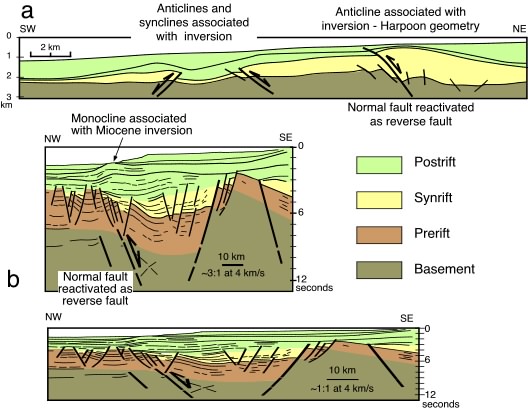 |
| Figure 3.3.1.4. Examples of positive inversion structures. a) Cross section across part of Sunda arc. During inversion, normal faults became reverse faults, producing synclines and anticlines with harpoon geometries (after Letouzey, 1990). b) Interpreted line drawings (with 3:1 and 1:1 vertical exaggeration) of AGSO Line 110-12 from Exmouth sub-basin, NW Shelf Australia (after Withjack & Eisenstadt, 1999). During Miocene inversion, deep-seated normal faults became reverse faults. In response, gentle monoclines formed in the shallow, postrift strata. |
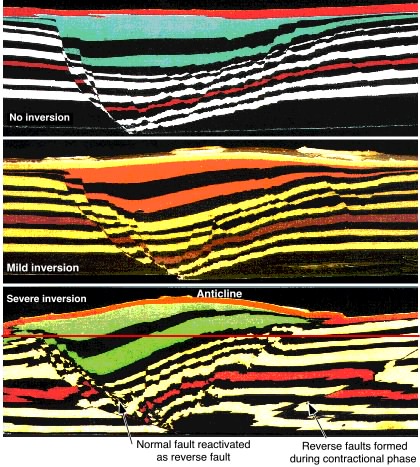 |
Figure 3.3.1.5. Experimental models of inversion structures. Cross sections through three clay models showing development of inversion structures (after Eisenstadt and Withjack, 1995). In each model, a clay layer (with colored sub-layers) covered two overlapping metal plates. Movement of the lower plate created extension or shortening. Thin clay layers are prerift; thick clay layers are synrift; top-most layer is postrift and pre-inversion. Top section shows model with extension and no shortening; a half graben containing very gently dipping synrift units is present. The middle section shows model with extension followed by minor shortening; a subtle anticline has formed in the half graben, and is associated with minor steepening of the dip of synrift layers. Bottom section shows model with extension followed by major shortening. The anticline in the half graben is more prominent, and is associated with significant steepening of the dip of synrift strata. New reverse faults have formed in the prerift layers. Although the inversion is obvious in this model, erosion of material down to the level of the red line would remove the most obvious evidence of inversion in the half graben. Furthermore, the prominent reverse faults cutting the prerift units could be interpreted to indicate prerift contractional deformation, as is common in the rift zones related to the breakup of Pangea. |
Stratigraphic Architecture
Numerous non-marine rift basins of varied geography and
geologic age share a remarkably similar stratigraphic architecture (Lambiase,
1990; Schlische and Olsen, 1990; Fig. 3.3.1.6). Known as a tripartite stratigraphy,
the section begins with basin-wide fluvial deposits overlain by a relatively
abrupt deepening-upward lacustrine succession overlain by a gradual shallowing-upward
lacustrine and fluvial succession. The key to understanding the significance
of this tripartite stratigraphy rests in the relationships among basin
capacity and sediment and water supply (Schlische and Olsen, 1990; Carroll
and Bohacs, 1999). Tectonics creates accommodation space or basin capacity.
Sediment supply determines how much of that basin capacity is filled and
whether or not lake systems are possible (Figure 3.3.1.7). In general,
fluvial deposition results when sediment supply exceeds capacity, and lacustrine
deposition results when capacity exceeds sediment supply.
 |
Figure 3.3.1.6. Stratigraphic architecture of Triassic-Jurassic rift basins of eastern North America. For tectonostratigraphic (TS) package III, nearly all basins exhibit all or part of a tripartite stratigraphy: 1, basal fluvial deposits; 2, "deeper-water" lacustrine deposits; 3, "shallow-water" lacustrine and fluvial deposits. The southern basins do not contain TS-IV. TS-I is only recognized in the Fundy basin and may or may not be a synrift deposit. Where TS-II is recognized, a significant unconformity (in terms of missing time) commonly separates it from TS-III. Modified from Olsen (1997), Olsen et al. (2000), and Schlische (2000). |
| Figure 3.3.1.7. [BELOW] Relationships among basin capacity, sediment supply, and volume of water determine the large-scale depositional environments of terrestrial rift basins. In example 1, basin-wide fluvial sedimentation is predicted. In example 2, shallow-water lacustrine sedimentation is predicted. For the basin capacity and available sediment supply shown in this example, no very deep lakes are possible because the excess capacity of the basin (and thus lake depth) is limited. Thus, under these conditions, climate is a relatively unimportant control on lake depth. In example 3, deep-water lacustrine sedimentation is predicted. |
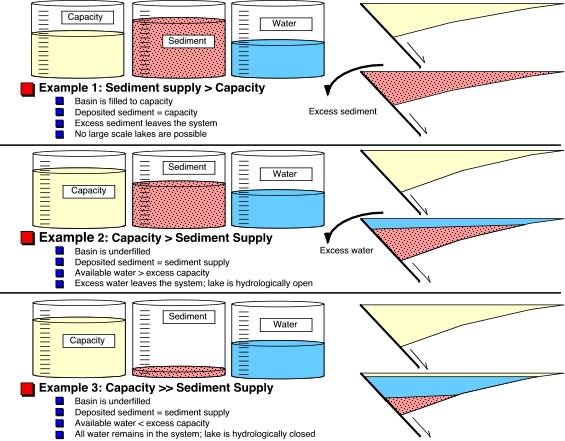 |
The relationships shown in Figure 3.3.1.7 allow us to
interpret the large-scale stratigraphic transitions observed in many non-marine
rift basins. The fluvial-lacustrine transition may result from an increase
in basin capacity and/or a decrease in sediment supply. The shallow-water
lacustrine to deep-water lacustrine transition may result from an increase
in basin capacity, a decrease in sediment-supply, and/or increase in the
available volume of water. The deep-water lacustrine to shallow-water lacustrine
transition may result from a decrease or an increase in basin capacity
(depending on the geometry of the basin's excess capacity), an increase
in the sediment supply, and/or decrease in the available volume of water.
How do we go about choosing the more likely interpretation? Interestingly,
all of the major stratigraphic transitions can be explained by an increase
in basin capacity, for which a simple basin-filling model is shown in Figure
3.3.1.3. Other basin filling models are described by Lambiase (1990), Smoot
(1991), and Lambiase and Bosworth (1995). As discussed in Section 3.3.3,
long cores from rift basins, combined with basin modeling (e.g., Contreras
et al., 1997) and seismic reflection data (e.g., Morley, 1999), are required
to test the predictions of these basin-filling models.
 |
| Figure 3.3.1.8. Idealized rift basin showing unconformity-bounded tectonostratigraphic packages. Thin black lines represent stratal truncation beneath unconformities; red half-arrows represent onlaps. In eastern North America, TS-I may not be a synrift deposit, and thus the geometry shown here would be incorrect. TS-II is much more areally restricted and more wedge-shaped than TS-III. The transition between TS-III and TS-IV is likely related to an increase in extension rate. An offset coring technique (vertical orange lines), as used in the Newark basin coring project, does not sample TS-I and most of TS-II. A deep core (vertical yellow line) is necessary to recover TS-I and TS-II. Modified from Olsen (1997). |
Tectonostratigraphic Packages and Basin Evolution
Olsen (1997) subdivided the synrift strata of central
Atlantic margin rift basins into four tectonostratigraphic (TS) packages
(Fig. 3.3.1.6, 3.3.1.8). An individual TS package consists of all or part
of a tripartite stratigraphic succession, is separated from other packages
by unconformities or correlative conformities, and generally has a different
climatic milieu compared to other TS packages. TS-I is a Permian deposit
that may or may not be synrift, whereas TS-II, TS-III, and TS-IV are Late
Triassic and Early Jurassic synrift deposits (Olsen et al., 2000).
The unconformities between TS-I, TS-II, and TS-III represent significant
geologic time. However, it is not yet clear if these unconformities are
related to regional tectonic changes (e.g., pulsed extension) (Olsen, 1997)
or to relatively local processes such as strain localization (a change
from distributed extension on lots of small faults to extension on a few
large ones; e.g., Gupta et al., 1998) (Fig. 3.3.1.9). Given their geometry
and location in the rift basin, TS-I and TS-II can generally only be sampled
through deep coring and not the relatively shallow offset coring utilized
in the Newark basin (Section 3.3.3). The rift-onset unconformity between
prerift rocks and various synrift units should not be taken as evidence
of regional uplift preceding rifting; rather, it more likely reflects erosion
and non-deposition occurring over a topographically elevated region resulting
from the assembly of Pangea.
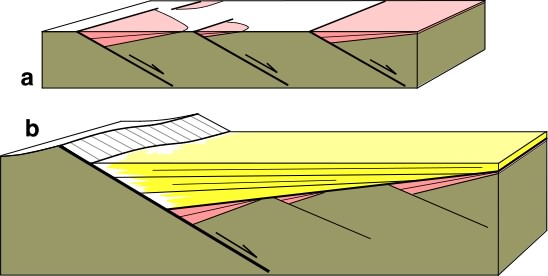 |
| Figure 3.3.1.9. Stages in the evolution of a rift basin. (a) Early rifting associated with several minor, relatively isolated normal faults. (b) Mature rifting with through-going boundary fault zone, widespread deposition, and footwall uplift and erosion. |
TS-III and TS-IV were deposited in much larger basins or subbasins than was TS-II, and the unconformity between them is small to non-existent (Olsen, 1997). TS-IV includes the widespread CAMP basalts that were erupted in a geologically short interval at ~202 Ma (e.g., Olsen et al., 1996; Olsen, 1999) (The CAMP basalts comprise a large-igneous province or L.I.P.; see Section 3.1.3). Significantly, TS-IV is absent in all of the southern basins of the central Atlantic margin. As discussed more fully in Withjack et al. (1998), TS-IV was probably never deposited in this region, indicating that synrift subsidence had ceased prior to TS-IV time. [A postrift basalt sequence, which may or may not be the same age as CAMP, is present in the southern region and plausibly can be connected to a seaward-dipping reflector sequence at the continental margin (Oh et al., 1995). The temporal and spatial relationships of these igneous rocks is a critical coring target; see sections 4.2.1 and 4.2.2.] Also significantly, basin inversion in the southern basins occurred shortly prior to and during TS-IV time, while inversion in the northern basins occurred after TS-IV time. (During TS-IV time, the northern basins underwent accelerated subsidence; see Figure 3.3.2.7). Thus, the end of rifting, the initation of inversion, and probably the initiation of seafloor spreading are diachronous along the central Atlantic margin (i.e., during earliest Jurassic time in the southeastern United States and Early to Middle Jurassic time in the northeastern United States and Maritime Canada) (Withjack et al., 1998). Coring, field analysis, and seismic-reflection profiles of synrift and immediately overlying postrift deposits and the structures formed in them, are necessary to clarify the important events occurring at the rift-drift transition.
The inferred diachronous initiation of seafloor spreading along the present-day margin of the central North America Ocean is part of larger trend that reflects the progressive dismemberment of Pangea. As the North Atlantic Ocean continued to develop, seafloor spreading propagated northward. For example, seafloor spreading between the Grand Banks and southwestern Europe began during the Early Cretaceous (e.g., Srivastava and Tapscott, 1986); seafloor spreading between Labrador and western Greenland began during the early Tertiary (anomaly 27N) (e.g., Chalmers, et al., 1993); whereas seafloor spreading between eastern Greenland and northwestern Europe began slightly later during the early Tertiary (anomaly 24R) (e.g., Talwani and Eldholm, 1977; Hinz et al., 1993).
References:
Barnett, J. A. M., Mortimer, J., Rippon, J. H., Walsh, J. J., and Watterson, J., 1987, Displacement geometry in the volume containing a single normal fault: American Association of Petroleum Geologists Bulletin, v. 71, p. 925-937.
Buchanan, J. G., and Buchanan, P. G., eds., 1995, Basin Inversion: Geological
Society of London Special Publication 88, 596 p.
Carroll, A.R., and Bohacs, K.M., 1999, Stratigraphic classification
of ancient lakes: Balancing tectonic and climatic controls: Geology, v.
27, p. 99-102.
Chalmers, J. A., Pulvertaft, C. R., Christiansen, F. G., Laresen, H. C.,Laursen, K. H., and Ottesen, T. G., 1993, The southern West Greenland continental margin: Rifting history, basin development, and petroleum potential, in Parker, J. R., ed., Petroleum Geology of Northwest Europe, Proceedings of the 4th Conference: Geological Society of London, v. 2, p. 915-931.
Contreras, J., Scholz, C. H., King, G. C. P., 1997, A general model of rift basin evolution: constraints of first order stratigraphic observations: Journal of Geophysical Research, v. 102, p. 7673-7690.
Cowie, P. A., 1998, Normal fault growth in three-dimensions in continental and oceanic crust, in Faulting and Magmatism at Mid-Ocean Ridges: Geophysical Monograph 106, American Geophysical Union, p. 325-348.
Dore, A. G., and Lundin, E. R., 1996, Cenozoic compressional structures on the NE Atlantic margin: nature, origin, and potential signficance for hydrocarbon exploration: Petroleum Geoscience, v. 2, p. 299-311.
Eisenstadt, G., and Withjack, M. O., 1995, Estimating inversion: results from clay models, in Buchanan, J. G., and Buchanan, P. G., eds., 1995, Basin Inversion: Geological Society of London Special Publication 88, p. 119-136.
Gawthorpe, R.L., Sharp, I., Underhill, J.R., and Gupta, S., 1997, Linked sequence stratigraphic and structural evolution of propagating normal faults: Geology, v. 25, p. 795-798.
Gibson, J. R., Walsh, J. J., and Watterson, J., 1989, Modelling of bed contours and cross-sections adjacent to planar normal faults: Journal of Structural Geology, v. 11, p. 317-328.
Gupta, S., Cowie, P. A., Dawers, N. H., and Underhill, J. R., 1998, A mechanism to explain rift-basin subsidence and stratigraphic patterns through fault-array evolution: Geology, v. 26, p. 595-598.
Hill, K. C., Hill, K. A., Cooper, G. T., O'Sullivan, A. J., O'Sullivan, P. B., and Richardson, M. J., 1995, Inversion around the Bass basin, SE Australia, in Buchanan, J.G., and Buchanan, P.G., eds., 1995, Basin Inversion: Geological Society of London Special Publication 88, p. 525-548.
Hinz, K., Eldholm, O., Block, M., and Skogseid, J., 1993, Evolution of North Atlantic volcanic continental margins, in Parker, J. R., ed., Petroleum Geology of Northwest Europe, Proceedings of the 4th Conference: Geological Society of London, v. 2, p. 901-913.
Katz, B. J., ed., 1990, Lacustrine basin exploration--case studies and
modern analogs: AAPG Memoir 50, 340 p.
Lambiase, J.J., 1990, A model for tectonic control of lacustrine stratigraphic
sequences in continental rift basins, in Katz, B.J., ed., Lacustrine Exploration:
Case Studies and Modern Analogues: AAPG Memoir 50, p. 265-276.
Lambiase, J. J., and Bosworth, W., 1995, Structural controls on sedimentation in continental rifts, in Lambiase, J.J., ed., Hydrocarbon habitat in rift basins: Geological Society Special Publication 80, p. 117-144.
Morley, C. K., 1999, Patterns of displacement along large normal faults: Implications for basin evolution and fault propagation, based on examples from East Africa: AAPG Bulletin, v. 83, p. 613-634.
Oh, J., Austin, J. A., Jr., Phillips, J. D., Coffin, M. F., and Stoffa, P. L., 1995, Seaward-dipping reflectors offshore the southeastern United States: Seismic evidence for extensive volcanism accompanying sequential formation of the Carolina trough and Blake Plateau basin: Geology, v. 23, p. 9-12.
Olsen, P. E., Schlische, R. W., and Fedosh, M. S., 1996, 580 kyr duration of the Early Jurassic flood basalt event in eastern North America estimated using Milankovitch cyclostratigraphy, in Morales, M., ed., The Continental Jurassic: Museum of Northern Arizona Bulletin 60, p. 11-22.
Olsen, P. E., 1997, Stratigraphic record of the early Mesozoic breakup of Pangea in the Laurasia-Gondwana rift system: Annual Reviews of Earth and Planetary Science, v. 25, p. 337-401.
Olsen, P. E., and Kent, D. V., 1999, Long-period Milankovitch cycles from the Late Triassic and Early Jurassic of eastern North America and their implications for the calibration of the early Mesozoic time scale and the long-term behavior of the planets. Transactions, Royal Society of London, Series A, v. 357, p. 1761-1786.
Olsen, P. E., 1999, Giant lava flows, mass extinctions, and mantle plumes [perspective on Marzoli, et al.]: Science, v. 284, p. 604 - 605.
Rosendahl, B. R., 1987, Architecture of continental rifts with special reference to East Africa: Annual Review of Earth and Planetary Science, v. 15, p. 445-503.
Schlische, R. W., 1991, Half-graben filling models: New constraints on continental extensional basin development: Basin Research, v. 3, p. 123-141.
Schlische, R. W., 1993, Anatomy and evolution of the Triassic-Jurassic continental rift system, eastern North America: Tectonics, v. 12, p. 1026-1042.
Schlische, R. W., 1995, Geometry and origin of fault-related folds in extensional settings: American Association of Petroleum Geologists Bulletin, v. 79, p. 1661-1678.
Schlische, R. W., 2000, Progress in understanding the structural geology, basin evolution, and tectonic history of the eastern North American rift system, in LeTourneau, P.M., and Olsen, P.E., eds., Aspects of Triassic-Jurassic Rift Basin Geoscience: New York, Columbia University Press, in press.
Schlische, R. W., and Anders, M. H., 1996, Stratigraphic effects and tectonic implications of the growth of normal faults and extensional basins, in Beratan, K. K., ed., Reconstructing the Structural History of Basin and Range Extension Using Sedimentology and Stratigraphy: GSA Special Paper 303, p. 183-203.
Schlische, R. W., and Olsen, P. E., 1990, Quantitative filling model for continental extensional basins with applications to early Mesozoic rifts of eastern North America: Journal of Geology, v. 98, p. 135-155.
Smoot, J. P., 1991, Sedimentary facies and depositional environments of early Mesozoic Newark Supergroup basins, eastern North America: Palaeogeography, Palaeoclimatology, Palaeoecology, v. 84, p. 369-423.
Srivastava, S. P., and Tapscott, C. R., 1986, Plate kinematics of the North Atlantic, in Vogt, P. R., and Tucholke, B. E., eds., The Geology of North America, v. M., The Western North Atlantic Region: Geological Society of America, p. 379-404.
Talwani, M., and Eldholm, O., 1977, Evolution of the Norwegian-Greenland Sea: GSA Bulletin, v. 88, p. 969-999.
Vågnes, E., Gabrielsen, R. H., and Haremo, P., 1998, Late Cretaceous-Cenozoic intraplate contractional deformation at the Norwegian continental shelf: timing, magnitude and regional implications: Tectonophysics, v. 300, p. 29-46.
Withjack, M.O., Olson, J., and Peterson, E., 1990, Experimental models of extensional forced folds: AAPG Bulletin, v. 74, p. 1038-1054.
Withjack, M. O. and Eisenstadt, G., 1999, Structural history of the Northwest Shelf, Australia -- an integrated geological, geophysical and experimental approach: AAPG Annual Meeting Abstract, v. 8, p. A151.
Withjack, M.O., Olsen, P.E., and Schlische, R.W., 1995, Tectonic evolution of the Fundy rift basin, Canada: Evidence of extension and shortening during passive margin development: Tectonics, v. 14, p. 390-405.
Withjack, M.O., Schlische, R.W., and Olsen, P.E., 1998, Diachronous
rifting, drifting, and inversion on the passive margin of central eastern
North America: An analog for other passive margins: AAPG Bulletin, v. 82,
p. 817-835.
| Previous |